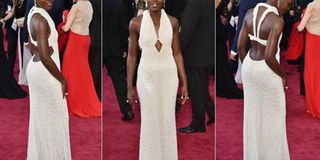Fashion lessons that Kenya can learn from the Oscars

A picture taken on February 22, 2015, actress Lupita Nyong'o poses on the red carpet in this combination image for the 87th Oscars in Hollywood, California. AFP PHOTO | MLADEN ANTONOV
What you need to know:
Our celebrities have a lot to gain by becoming fashion and media savvy, skill sets that can allow one to mingle and impress on the world stage.
They have to start shinning at local and regional red carpet events.
Some 6,000 hand sewn pearls and a lean nude-meets-glow-coloured after party gown later, Lupita Nyong’o’s bespoke Calvin Klein Oscar outfits made headlines. Again, she stood out in a sea of beauties. This year has been a rather subdued red carpet year for her. After all she isn’t pushing any projects.
What Lupita did along with other beautiful Hollywood actors, was support #AskHerMore, a campaign started by The Representation Project, a group dedicated to ending gender stereotyping in film. Its purpose was to inspire creative, interesting interviewing on the red carpet. Lupita said, “I enjoy being asked about my crafy, my profession. Fashion is something that I think of as an extracurricular interest.”
Red carpet coverage started 17 years ago with E! and the late Joan Rivers. Now a juggernaut, their live three-hour telecast transmits to 350 countries beaming what is no doubt the pinnacle of film and fashion with a side of music.
But when an Oscar winner and red carpet veteran got sick of answering the leading red carpet question, “who are you wearing?” preferring to discuss more than just her Glam Squad, it attracted fascinating reactions. The hash tag spilled into mainstream media and dresses competed with it alongside the Best Actress speech.
And just like that, the escapism of the red carpet was blown up into a larger scale of a standard, worldwide issue: women earn far less than men, more opportunities exist when we are pretty, younger things, women have to spend more to look like movie stars even when they are, in fact, already movie stars. It highlighted a double standard where men are assessed by achievements and women judged by looks.
Unspoken conversations
Film and fashion occupy central social, cultural and political roles. They express, agitate and inspire oftentimes unspoken conversations. They draw inspiration from each other. This hash tag could be a seed of a shift in this relationship.
Especially as more women opt for independent projects as writers, producers and directors to optioning books like Lupita did with Chimamanda Adichie’s Americanah.
Industries and careers have been built on and around the red carpet. To focus more on the woman in the dress than the dress in an age of strictly choreographed interviews can get tricky.
Presently, the average cost of an Oscar look has grown from Sh9.1 million to walking the red carpet in jewelry costing as much as Sh615 million with celebrities getting paid to endorse or wear brands.
Red carpets have become a measure of cachet and net worth. Media uses it to put women on the map. Celebrities are pop culture currency.
Now a Hollywood star, Lupita’s nothing short of divine relationship with her team including stylist Michaela Erlanger inspired the world to fall in love with her.
Fashion played a leading role in her rise from critical magazine covers straight into the arms of Lancôme. So long as this kind of relationship between fashion and film exists, who you’re wearing remains pertinent.
On the other hand, imagine for a moment if Lupita had been asked about her theatre background, her directing and producing experience, how she thinks Kenya and yes, Mexico, feel about her or what the Kenyan film industry needs to do to get more Lupitas on the red carpet.
Media savvy
Kenya has not asked “who are you wearing?” enough. Our celebrities have a lot to gain by becoming fashion and media savvy, skill sets that can allow one to mingle and impress on the world stage. Add to that considered, relevant red carpet events locally and regionally, and you begin to understand how much opportunity fashion carries for professional growth.
I, for one, would love to stop referencing Nollywood and South Africa as the glitz and glamour gold standard. Kenya needs the razzle dazzle.
A country that celebrates the arts: film, fashion, music, dance, literature and art, is one whose artists are not starving. We need to ask “who are you wearing?” till we are so sick of it someone starts a campaign. But not just yet.
Not until fashion houses have advertising and marketing budgets worth millions, are listed on the NSE, can hire spokespersons and brand ambassadors and can afford 25 specialised hands on deck for the hundreds of hours it takes to custom-make a couture gown for personalities who have captured the imagination.
There is plenty of room for that.





